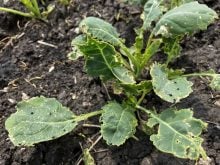Now is the time to evaluate how your canola hybrids fared this year and to pencil in the varieties that give you the best chance for the best returns next year.
With yield data and overall cost of production in your pocket, growers can compare which varieties provided the best returns under the specific weather conditions experienced this summer.
The Manitoba Canola Growers recently held a Twitter poll that asked, “When it comes to your 2021 canola hybrids what is the biggest deciding factor.”
Of the 228 respondents, 46 percent chose yield, 43 percent said pod shatter/standability, seven percent answered special financial offers and only four percent chose clubroot genetics.
Read Also

Growing garlic by the thousands in Manitoba
Grower holds a planting party day every fall as a crowd gathers to help put 28,000 plants, and sometimes more, into theground
Justine Cornelsen said it’s understandable why yield and standability are so important to growers, especially for those who haven’t had major disease issues, but disease packages are also important to consider.
“If clubroot is a problem on your farm or within your area we do recommend clubroot genetics. We’re trying to get all acres to be clubroot genetics eventually,” Cornelsen said.
“So if you’re in an area where you don’t have clubroot and haven’t experimented with any clubroot resistant varieties, put it on a high risk field where you get lots of traffic.”
Fall is a great time to look for disease patches on your fields to sample and test, to better understand which pathogens you’re dealing with.
“When you go across your entire field you’ll be able to identify areas that were potentially lower yielding or where there was a little more disease, so like a patch of blackleg or clubroot would be fairly evident,” Cornelsen said.
Taking a soil sample now will provide a good indicator of what level of clubroot spores there are within your field.
Soil samples for clubroot should be taken in field entrance ways, any high traffic areas, water ways and low spots.
“I do recommend taking direct samples. Don’t mix samples because you want to know where the high concentration patches are and you don’t want to be combining them across the field because it’s going to dilute your sample down,” Cornelsen said.
She said it’s a good time to look for verticillium wilt because symptoms are more evident later in the season, even though there aren’t any varieties registered as resistant to verticillium. It is important to know if growers are dealing with verticillium, because if it turns out to be blackleg, there are options.
“If you’re seeing lots of pressure (from blackleg) and growing that particular hybrid wasn’t working, this would be a great opportunity to switch to something else,” Cornelsen said.
“Blackleg doesn’t become an issue until you have a wipe-out or an accident from it. A few producers this year were definitely dealing with some blackleg oopsy-daisies.”
Beyond looking for and testing disease patches, it’s also a good time to check plant stands to validate target plant stands were achieved.
A hoop with a 56-centimetre diameter or a 50-by-50 cm square is equivalent to one quarter sq. metre.
Cornelsen said it’s sometimes difficult to know which plants were contributing to yield, and that tiny-stemmed plants are usually not counted.
“Just go back and check what your seeding rate was, what your target plant stand was and from there you can figure out what your plant survivability was,” she said.
“It’s a good time to get that full year view, look at the hybrids that you were growing this year. Do your comparison on the farm. Look at your seed guides, your life science guides and the resistance packages to help pick that hybrid and the genetics you’re needing on your farm.”


















